Abstract
Pathways leading to a carbon neutral future for the German energy system have to deal with the expected phase-out of coal-fired power generation, in addition to the shutdown of nuclear power plants and the rapid ramp-up of photovoltaics and wind power generation. An analysis of the expected impact on electricity market, security of supply, and system stability must consider the European context because of the strong coupling—both from an economic and a system operation point of view—through the cross-border power exchange of Germany with its neighbors. This analysis, complemented by options to improve the existing development plans, is the purpose of this paper. We propose a multilevel energy system modeling, including electricity market, network congestion management, and system stability, to identify challenges for the years 2023 and 2035. Out of the results, we would like to highlight the positive role of innovative combined heat and power (CHP) solutions securing power and heat supply, the importance of a network congestion management utilizing flexibility from sector coupling, and the essential network extension plans. Network congestion and reduced security margins will become the new normal. We conclude that future energy systems require expanded flexibilities in combination with forward planning of operation.
1. Introduction
1.1. Motivation and Relevance
Germany is entering the next phase of the energy transition. In the previous phase, the focus was on expansion of renewable generation capacity, which was largely an addition to the existing fleet. With the political decisions on nuclear phase-out, already part of the German grid development plan [1], and now additionally coal phase-out (see Federal Ministry for Economic Affairs and Energy (BMWi) [2]), the reduction in existing conventional generation capacities will become evident in the next years. Both coal and nuclear phase-out are not German-specific trends, but can be observed in several European countries (see, e.g., the national energy and climate plans of the European Commission [3]). For Germany, the recommendation of the so-called “coal commission” describes the framework for coal phase-out until 2038, with the explicit option to reach the target in 2035 (see Federal Ministry for Economic Affairs and Energy (BMWi) [2]). Understanding the full consequences of reducing conventional generation capacities while at the same time further ramping up renewables needs an in-depth analysis with a European scope. On the one hand, the more obvious questions such as “security of supply” need to be answered considering the strongly interconnected European energy system; on the other hand, complex interdependencies with respect to, e.g., “system stability” need to be analyzed, as partially addressed by the German Energy Agency (DENA) [4]. Regarding the electricity sector, the analysis has to take the European electricity market and cross-border exchange into account. Furthermore, it is important to note that most German coal power plants provide not only electricity, but also heat for district heating networks in the nearby communities (see, e.g., [5]). Security of supply needs to be maintained for both electricity and heat obligations. Thus, a cross-sector energy system modeling of Germany embedded into the European system with a deep dive into system and grid stability is required to adequately describe the consequences of the German coal phase-out. This study provides comprehensive analyses of the plans for the German coal phase-out, identifies shortcomings, and proposes solutions for an economic, secure, and environmentally friendly implementation of the coal phase-out plans. The method and the general results can be applied to all regions globally that are facing similar challenges driven by the need for decarbonization of the energy system.
1.2. State of the Art and Related Work
There are already studies analyzing a coal phase-out in Germany prior to recent political decisions. Most studies have a long-term investigation horizon. However, they differ in their focus and object of investigation.
Some studies examined the coal phase-out from the perspective of reducing emissions and achieving climate targets. Oei et al. [6] and Bartholdsen et al. [7] analyzed the long-term transition of energy supply in Germany in this context. Detailed technical aspects of energy supply infrastructure were not in the scope of their investigation and were only considered partly, e.g., by region models. Kittel et al. [8] considered various scenarios for coal exit in Germany. In this study, phase-outs were compared with operational limitations with regard to the CO2 balance. Other studies had a stronger economic focus. Matthes et al. [9] analyzed the effects of different scenario frameworks on the electricity market with respect to a coal phase-out. Similarly, the Institute of Energy Economics (EWI) [10] compared a scenario on the basis of the decision of the coal commission with a reference scenario that follows the previous trends. Results focused on systemic variables such as the electricity price or the import/export balance. Keles and Yilmaz [11] evaluated the German coal phase-out from a European perspective and compared this with other instruments such as the CO2-pricing. Moreover, Oei et al. [12] considered local aspects of concerned regions. In contrast, [13] had a stronger technical focus. According to market scenarios, the potential for spinning reserve supplied by power plants was examined. DENA [4] evaluated the impact of the German nuclear and coal phase-out on the provision of auxiliary services for system security with the years 2030 and 2050 in focus. A detailed analysis of the German electrical transmission grid for the year 2035 with regard to congestion volumes was given by Hladik et al. [14]. In this context, market splitting was also discussed as an instrument of congestion management.
To the authors’ knowledge, no previous study on coal phase-out included a holistic analysis of the energy system. Thus, there is a gap of knowledge in the end-to-end consideration of coal phase-out scenarios in which various relevant economic and technical processes of energy supply are simulated and investigated in a coherent manner. In addition to the electricity system, the simulation framework of this study also includes other sectors that are interlinked, such as heat supply or transport. Not only detailed market effects are considered, but also effects on the electricity grid infrastructure. In supplement to static analyses through power flow calculations, the stability of the transmission grid is evaluated considering grid dynamics.
1.3. Contribution and Structure
This study aims at analyzing the impact of the German coal phase-out on electricity markets, security of supply, and system stability. The impact is investigated within the European context to take into account the strong coupling between Germany and its neighbors through the power exchange. The German measures are embedded into the European electricity market and the European electrical transmission (380, 220 kV), complemented by securing the heat obligations of shut-down coal-fired combined heat and power (CHP) plants. This paper focuses on the years 2023 and 2035, motivated by the time schedule of nuclear and coal phase-out in Germany. To analyze the effect of future developments on the energy system, several sensitivities concerning innovative CHP, a delayed grid expansion, or curative congestion management concepts and operation strategies are carried out. The modeling approach includes an energy mix optimization, a market model, the power flow and network congestion management simulation, and an aggregated stability analysis.
First, we explain the underlying assumptions and scenarios for the modeling. Then we recapitulate the most important modeling approaches. We keep this part as brief as possible, referring to the literature. In the last part, we present selected results to security of supply, network congestion management, power system stability, renewable extension plans in Germany, and the defossilization of the German energy sector. After discussing the results and positioning with other system studies, we end with conclusions.
2. Materials and Methods
2.1. Assumptions and Scenarios
Firstly, the two base scenarios modeling a German coal exit within the European market aim at generating a consistent representation of currently available national plans for their energy systems. The scenarios and their underlying assumptions can be divided into different categories on the basis of installed capacities, time series, price assumptions, and the grid scenario, see Table 1. The general assumptions for these categories in the base scenarios are described in the first subchapter. Secondly, the deviations from the base assumptions in further sensitivities are described.

Table 1.
Overview scenarios and sensitivities.
2.1.1. Base Scenarios
Installed capacities: For Germany, the focus country of this study, the scenarios are based on the planning as published in the German grid development plan (NEP) 2019 [1]. Therein, we choose scenario B which assumes moderate sector coupling with decentral elements. For 2023, conventional installations (except for coal power plants) are based on the published planning in the power plant list [15], and renewable installations are interpolated between the current value and the target in scenario B 2025. The interpolation results in 62 GW installed capacity for photovoltaics (PV), 63 GW for wind onshore, and 8.8 GW wind offshore in the year 2023. For 2035, scenario B 2035 is combined with the unit specific power plant list. The renewable installation assumed in B 2035 involves 97 GW of PV, 91 GW wind onshore, and 23 GW offshore. The capacities of coal power plans in the focus years 2023 and 2035 are complemented by the proposals of the commission elaborating a plan for a German coal exit [16]. Therein, we assume the realization of the proposed option for an early coal exit in 2035. In 2023, the publicly available total capacity of lignite and hard coal power plants (15 GW/15 GW) is met by shutting down (1) power plants which are already planned to be shut down in this period, (2) shutting down the oldest power plants, and (3) still considering for lignite that contracts for opencast mining have to be fulfilled. Basis for this selection process is the power plant list provided by the NEP [15]. To compensate for potential heat obligations of shut-down power plants, three rules are applied: (1) some power plants are already substituted by innovative combined heat and power (CHP) approaches in the NEP. Those substitutions are directly included in our scenario. (2) For many of other power plants, we researched individual values, e.g., according to [5]. (3) Lastly, for CHP power plants without accessible heat generation values—which is the case for around 10% of all power plants—we assumed a CHP coefficient of 1. The detailed demand structure for household and industrial electricity and heat is computed by using the distributions in [17]. The study projects in detail the commodities which cover the energy demand in each sector. As such, the demand for specific technologies such as heat pumps or district heating can be derived. Since the study has not been conducted for the target years 2023 and 2035, these values are calculated by interpolating between the two closest available years.
To define the assumptions concerning the European power system in 2023 and 2035, the main sources are official planning documents provided by the European Network of Transmission System Operators for Electricity (ENTSO-E). For 2023, we consider an interpolation between the “best estimate” scenarios 2020 and 2025 in the Midterm Adequacy Forecast (MAF) 2018 [18]. For 2035, the Sustainable Transition scenarios 2030 and 2040 from the Ten-Year Network Development Plan (TYNDP) 2018 [19] are interpolated. The Sustainable Transition scenario corresponds best with scenario B chosen in the NEP for Germany. However, several countries such as Germany updated their policies and planning after the publication of these ENTSO-E plans. Therefore, for neighboring and other Western European countries, affecting the German energy system most, we update the MAF and TYNDP values using official governmental sources such as the National Energy and Climate Plans [3], the “Programmation Pluriannuelle de l’Énergie” in France [20], or current nuclear plans in the United Kingdom (UK).
Time series: All considered time series are based on the weather year 2012 to ensure a realistic hourly simulation. Therefore, the historical data, taken from the ENTSO-E transparency platform [21], are scaled by the projected demand [19]. The profiles of wind and solar generation are scaled by full-load hours which are computed on the basis of simulations in the TYNDP.
Price assumptions: Important prices affecting the market simulations are fossil fuel prices and the price for CO2 emissions. In this paper, all prices are given in EUR of 2018. Fossil fuel prices are based on the IHS Markit Rivalry scenario [22], while the CO2 price (20 EUR/t in 2023 and 27 EUR/t in 2035) is based on the NEP [1].
Grid scenario: Another important part of the scenario framework involves the assumptions about the European transmission grid in the two considered years. Here, we differentiate again between a detailed consideration of Germany according to the NEP and an overall consideration of the European plans in the TYNDP. As a result, for the base scenario 2023, we consider all measures which are stated in the NEP with a commissioning date up to the end of 2022. None of the planned high-voltage direct current (HVDC) systems within the German electrical transmission grid are included in these measures. By contrast, in 2035, more than 100 measures are integrated into the German extra-high-voltage grid. Therein, we only consider confirmed measures. Furthermore, we just evaluate planned measures for the target year 2030 as historical analysis shows an average delay of 5 years for the implementation of new measures in recent years [1,23,24,25,26,27]. Out of nine planned HVDC systems within Germany, five are realized in our 2035 scenario. All NEP assumptions for interconnectors between Germany and foreign countries match the TYNDP lists of measures.
For the European scenario, we use the same MAF/TYNDP scenarios as for the installed capacities and differentiate between direct and alternating current (DC and AC) grid connections. AC connections are for both years 2023 and 2035 interpolated between available years. For DC connections, we do a project-specific evaluation. As an example, we do not include the DC link “NeuConnect” in the 2023 scenario as it is expected to be finished during the year 2023, but then we include it in the 2035 scenario. In general, DC links are considered as contributing 100% to the net transfer capacity (NTC) value used in the market modeling.
2.1.2. Further Sensitivities
To analyze sensitivities in the defined base scenarios and to represent the potential for further developments, we define further scenarios changing details compared to the base scenario of the respective years:
- InnoCHP (2023, 2035): The heat obligations of CHP power plants, which are shut down, are fulfilled by an optimized mix of innovative heat generation units. A detailed description of the optimization process to find these innovative units is described in Section 2.2.5. Calculation of InnoCHP Capacity Built up.
- CO2 price (2023, 2035): As the assumed CO2 prices are comparably low for the base scenarios, the impact of higher CO2 prices on the electricity market is another sensitivity. Therefore, the prices are increased to 40 EUR/t (2023) and 100 EUR/t (2035) [28].
- Grid 2023+ (2023): The grid sensitivity 2023+ describes the planned grid expansion status at the end of the year 2023. It differs significantly from the base scenario since, during the year 2023, for example, several phase shifting transformers (PSTs) and, with Ultranet, the first HVDC systems in the German electrical transmission grid are planned to be installed
- GridFlex (2035): Reacting to the increasing amount of variable renewable energy sources in the grid, new concepts for grid operation are discussed. We assume in this sensitivity a preventive, as well as curative (i.e., curative, when a contingency occurs), grid operation and new technologies supporting the grid with ancillary services such as grid boosters. The sensitivity GridFlex is divided in three scenarios: the scenario GridFlex 1 contains 12 central grid boosters, the scenario GridFlex 2 focuses on decentral flexibility, and the scenario GridFlex 3 investigates the curative operation of HVDC systems and PSTs. In each scenario, a temporarily admissible transmission loading (TATL) of about 120% of the permanently admissible transmission loading (PATL) is taken into account [29]. Within the scenario GridFlex 3, it is assumed that the complete operating range of power flow controlling devices can be used for curative interventions.
- Onshore–Offshore Shift (2035): Since the expansion of onshore wind is lagging official plans [30], this scenario includes 10 GW additional offshore wind units compared to the NEP B 2035 scenario. The capacities, producing an equivalent annual amount of energy as this 10 GW, are then subtracted from the installed wind onshore capacity. The power-to-gas capacity is adjusted to 6 GW by a separate energy system optimization of the German electricity system described in Section 2.2.7.
- NoSuedOstLink (2035): Analyzing the urgency of HVDC systems within Germany, we define one scenario without the HVDC system SuedOstLink, one of the major planned DC links.
2.2. Modeling Approach
2.2.1. Overview
In the following, we first introduce the three main steps of our model-based scenario evaluation: (1) European electricity market modeling, (2) analysis of the transmission and sub-transmission network including network congestion, and (3) analysis of the resulting power system stability. The remaining three subsections describe our methodology used to extend or improve the base scenario with respect to security of supply and sustainability. Here, we start with deriving an improved substitution of coal-fired power plants with heat obligation. After this, we describe the method for analyzing the potential of industrial green hydrogen in the Lausitz area to mitigate phasing out the lignite industry. In the end, we present the modeling used to adapt additions power to gas capacities integrating additions offshore wind parks.
2.2.2. Market Model
To derive electricity and heat demand on a local level, a bottom-up modeling approach based on high granular socio-economic data is used. These data include information on private households, commercial, trade, and services (CTS), and industry data on postal-code area and community level. For industrial processes, different temperature levels are considered. This information is used to assign decentralized and central electricity and thermal load coverage. The resulting time series serve as input for the market simulation. A detailed explanation of this method is given in [31,32].
Within the framework of this study, a model of the European electricity market is used. The interaction with other sectors (heat, gas, mobility) is also taken into account. A two-level approach, the European multimodal market simulation (EMMS), also applied in [31], is carried out.
The first level of EMMS consists of a simultaneous linear optimization of electricity and heat supply. All individual units participating at the electricity market (power plants, storages) are considered. The gas sector is included by considering power-to-gas units. The international electricity exchange is modeled using NTC assumptions. The model is explained in detail in [32].
As a result of the first level, the heat output of power plants is fixed. On this basis, an electricity market simulation formulated as a Lagrange relaxation of a mixed-integer problem is calculated, providing the zonal electricity prices though the Lagrangians. The international electricity exchange is endogenously included. A detailed description can be found in [33].
Figure 1 gives an overview of the total market simulation process.

Figure 1.
Overview of the European multimodal market simulation (EMMS) model [31].
2.2.3. Network Simulation and Preventive, as Well as Curative, Congestion Management
According to generation and demand time series provided by the bottom-up modeling and the electricity market simulation, the electrical transmission grid operation is simulated using the approach proposed in [31,34]. The transmission grid simulation allows the identification of market and grid related interventions required for ensuring N-1 system security and contains two steps. Firstly, the flows and voltages in the network are calculated by performing an AC power flow simulation. In a second step, a contingency analysis is carried out within a congestion management model to identify the cost-minimal interventions for alleviating the bottlenecks.
The congestion management model is formulated as a mixed-integer linear programming (MILP) problem and aims at minimizing overall costs for satisfying the N-1 criterion. For dissolving bottlenecks, the control of high-voltage direct current (HVDC) systems and phase shifting transformers (PSTs), redispatch of conventional generation units and storages, feed-in management (onshore and offshore wind, as well as PV units), power-to-gas and power-to-heat units, and cross-border redispatch are taken into account. The congestion management model contains both preventive and curative interventions. While preventive actions are implemented in the pre-fault situation, curative interventions are taken post fault. Hence, the pre-fault utilization of the network structure can be increased. The modeling of curative congestion management interventions is described in detail in [35].
The impact of market- and grid-related actions and system security constraints concerning the N-1 criterion are modeled by linear sensitivities, namely, power transfer distribution factors (PTDFs), phase shifting distribution factors (PSDFs), and line outage distribution factors (LODFs).
2.2.4. Stability Analyses
In addition to steady-state analyses, the dynamic properties must be assessed to evaluate the stability of power systems and, thus, their reliability. To this end, the full generation and load time series is assessed after congestion management. Classically, power system stability is divided into frequency stability, rotor angle stability, and voltage stability [36]. These stability aspects are the focus of our work. To investigate these aspects, three different methods are applied (Figure 2). Note that these methods only enable an indicative stability study since no detailed time-domain simulations are carried out.

Figure 2.
Overview of stability analyses.
The inertia analysis includes the calculation of the rate of change of frequency (RoCoF) and the acceleration time constant of the grid Tgrid for the generation and load time series. It is used to investigate the frequency stability on the basis of the initial system response to active power imbalances. To this end, active synchronous machines contribute to Tgrid as a function of their acceleration time constant Ta,SG,n and their nominal power Pnom,SG,n relative to the current system load PLoad.
The RoCoF is calculated for the maximum permissible load imbalance ΔPimbalance = 3000 MW (according to the reference incident for Continental Europe [37]) as a function of the rated frequency f0 = 50 Hz.
The current value of Tgrid in Continental Europe region ranges from 12 s to 15 s [38]. The definition of required RoCoF withstand capabilities for generation units lies within the responsibility of each transmission system operator with a maximum admissible value of ±2 Hz/s as proposed by the ENTSO-E [38].
Short-circuit calculations are carried out to determine the subtransient short-circuit power Sk″ according to [39] and using the Takahashi method. To this end, the voltage magnitudes are assumed as 1 pu. The short-circuit power is used to evaluate both rotor angle and voltage stability according to [40]. Thus, rotor angle stability is assumed for each synchronous machine when the rated power of all synchronous machines connected to a bus complies with
Additionally, voltage magnitude steps must be limited to 2% of the rated voltage. The voltage step ΔU can be approximated on the basis of the initial voltage U0 for a reactive power imbalance ΔQimbalance.
Thus, the system’s capability to maintain the voltage magnitude within the operational limits can be used to assess the short-term voltage stability. For instance, the switching of a reactive power compensator can be assessed.
Lastly, the reactive power demand of the transmission grid (220 kV and 380 kV level) is evaluated and compared to the installed compensation capacity. It is distinguished into inductive and capacitive demand and aggregated into grid regions. To this end, the reactive power demand of each overhead line Qohl, cable Qcable, and transformer Qtrafo is calculated.
Hence, we assume that the reactive and capacitive reactive power within a region are compensating for each other. The resulting Qregion is compared to the reactive power reserves of each region, which comprises reserves from HVDC terminals , conventional power plants Qconv, and reactive power compensators Qkomp. Reactive power compensators include mechanically switched reactors and capacitors, as well as static synchronous compensators (STATCOMs). Thus, we can evaluate if the reactive power demand can be met, by comparing the maximum inductive or capacitive demand in a region to the sum of all corresponding reserves. An insufficient reserve enables an indicative evaluation of long-term voltage stability.
2.2.5. Calculation of InnoCHP Capacity Built Up
One option for replacing coal power plants is to build gas-fired combined heat and power plants at the former coal generation sites. In many cases, heat from coal power plants is currently used in the city’s district heating system or for industrial applications. After shutting down the coal power plants, not only does the electricity generation have to be replaced but also the heat supply. In this paper, a scenario is conducted where innovative hybrid heat and power generating systems, i.e., multicomponent systems including, for example, a CHP plant, thermal storage, heat pump, and electric heater, are used for the replacement of the heat supply. Figure 3 shows how such an innovative CHP plant can react to different situations, especially with regard to electricity price and heat demand. If prices are, e.g., very low, the system can take electricity from the grid, transform it into heat via electric heater, and then either use it directly (if heat demand is available) or store it in hot water tanks. For high electricity prices, the CHP will run and produce electricity for selling to the grid. The generated heat can be either stored or used directly depending on the heat demand situation.
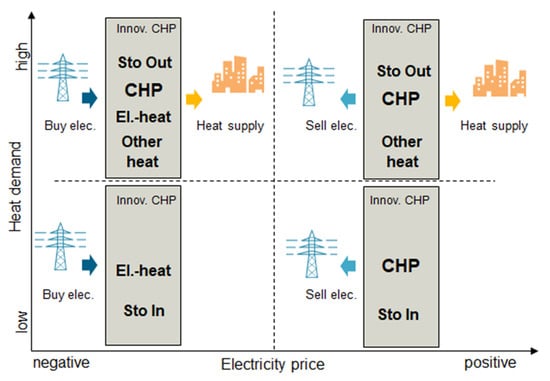
Figure 3.
Overview of operation modes for innovative CHP solutions (figure adjusted from [41]).
The design of each of these innovative CHP systems is based on a general rule which was derived from specific system optimizations. Therefore, different generation and storage technologies were available for an optimizer, i.e., the Energy System Development Planner (ESDP) (see [31]). The optimizer can then find the optimal combination and capacities of the different elements. Figure 4 on the left shows the idea of the optimization process. The components, which can be selected from the optimizer, are defined by their efficiencies and cost parameters (techno-economic parameters). The major constraint for the optimization process is the satisfaction of the thermal load (orange line) while maximizing the profits from selling and buying electricity at the spot market according to the simulated prices (blue chart). As there are many different heat sinks where new innovative CHP solutions could play a role, several typical situations were chosen and the systems were optimized accordingly. By taking the different results, a general rule for the design of the CHP systems was defined (see Figure 4 on the right) and applied to all heat sinks that remain without supply after the coal phase-out. The applied rule adds new CHP according to information of the required thermal power in each site. Figure 4 on the right shows the rule and the technologies that are applied. The model so far does not explicitly model operational flexibilities such as required time for restarts but this could be extended in future research, e.g., using an approach as described in Kryzia et al. [42], including the real options approach, the net present value method, and Monte Carlo simulations.
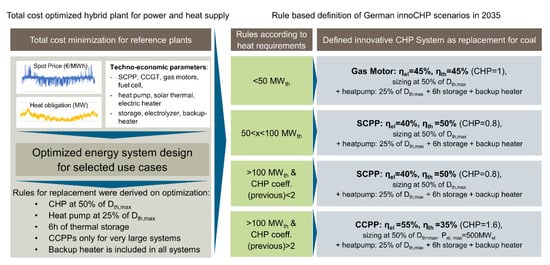
Figure 4.
Optimization of components for innovative CHP systems and derivation of a rule-based replacement of all heat sinks left after coal exit. The figure on the left shows the method to derive cost-optimal CHP configurations by using timeseries of heat demand and electricity prices, as well as techno-economic parameters of the available technologies. The derived rules are depicted on the right and show the technology configuration depending on the heat requirements of the system to be replaced by innovative CHP.
2.2.6. Industrial Green Hydrogen
The “Lausitz” region which is in the eastern part of Germany and reaches into parts of Poland has lately been a region facing an energy economic debate [43]. The debate centers around transitioning coal plants and the entire region into an overall more sustainable region with a high share of renewable generation assets. Driven by efforts to phase out coal-fired plants [2], the Lausitz region is furthermore used as one sandbox example by politicians seeking to transform other coal dominated regions in Germany.
We, therefore, analyze the case of the Lausitz region in order to depict a regional transition from a formerly lignite coal-dominated region into a future renewable region. Our techno-economic analysis builds upon a regional hybrid renewable energy system concept consisting of solar plants, wind turbines, and electrolyzers suppling green hydrogen as carbon-free fuel to the local existing chemical industry in the Lausitz area. The future energy region concept makes use of the strong coupling to the public power system and the economical usable renewable potential and the given industrial H2 demand. For the local H2 demand and the renewable potential, [44] provides a detailed Geographic Information System (GIS) based analysis showing the breakdown of the potential and commissioning options for both solar plants and wind turbines. According to scenarios within [44], different renewable potentials are derived, whereas we follow and use a conservative estimation approach for the renewable potential considering locational power quality to a threshold value of 80% (locational power quality determines the (achievable) output of a renewable asset in a specific location compared to a reference location. The reference location is described in the German Renewable Energy Sources Act (EEG) 2017, attachment 2). Additionally, restricted areas such as natural reserves and other restricted areas within the Lausitz region are deducted from the renewable potential, resulting in an overall economically usable renewable potential of 6.8 GW that is split into 5.1 GW of solar plants and 1.7 GW of wind turbines.
A 5 year annual full-load hours average (in the region, wind turbines are based on 1650 h/year (solar plants 1092 h/year)) including curtailment values is taken from the balancing responsible for the Lausitz region [44,45] in order to compute annual average power output. Capital and operating expenditures and efficiency rates for electrolyzers are taken from the literature [46,47]. We assume investment costs to be at approximately 500 EUR/kWel for the electrolyzer investment in 2035 and 15 EUR/kWel/a for the operational expenses at an efficiency rate of 0.7. Installation of electrolyzers is assumed to be close to H2 demand centers determined by the local industry.
Given all data, we depict the green hydrogen concept in the Lausitz region for the year 2030, then estimate the supply chain costs, and benchmark the green hydrogen production price against a conventional steam methane reforming process given with its respective capital and operational expenditures. For the green hydrogen production price, we derive production cost of the entire H2 supply chain by considering the levelized cost of electricity for the renewable system according to the usable potential [48,49] and adding the capital and operating expenditures for the electrolyzer per unit of output. With this, we are able to derive a static cost parameter for supplying green hydrogen to the local industry, neglecting any possible gas extension due to the onsite placement of the electrolyzer. The benchmarking steam methane reforming price is likewise calculated in a bottom-up cost estimate, relying on natural gas assumptions and CO2 certificate prices in 2030 (see Section 2.1, as well as capital and operational cost estimates for the steam methane reforming process derived from [50].
2.2.7. Optimization of Electrolyzer Capacities for Re-Electrification
Since onshore wind power faces acceptance problems in large parts of Germany and its expansion is slowing down, offshore is seen as an option to reach the climate targets in the electricity sector [51]. To analyze the impact of such a shift from onshore to offshore wind power generation, a scenario was developed on the basis of the NEP C 2030 [1], with a 10 GW increase in offshore generation to 27 GW, and a reduction in onshore to 70 GW, which corresponds to a decrease of about 16.5 GW. These numbers were chosen to keep the total energy generated by wind power at about the same level.
However, not only wind turbines face problems in their expansion; the transmission power grid also faces these problems [1,52]. Therefore, the optimizer used to calculate the optimal energy system setup could build additional electrolyzers to circumvent the bottlenecks in the power grid.
To model this sensitivity, the Energy System Development Plan (ESDP) [32] is used. Germany and its grid neighbors, The Netherlands, Belgium, Luxemburg, France, Switzerland, Austria, Czech Republic, Poland, Sweden, Denmark, Norway, and Great Britain, are in the scope of the model, where Germany is divided in its 38 Nomenclature of Territorial Units for Statistics regions of level 2 (NUTS2). Thus, in total 50 regions are modeled. Each region has an electricity demand, which must be met, as well as heat demands in the German regions of the model. Moreover, availability time series are individual for each region, as well as installed capacities of generation technologies. Energy exchange between these regions is done via a simplified net transfer capacity (NTC) model, where the optimizer can set the power transmission in the limits of the installed grid capacities. Effectively, our approach treats the regions as a bus in a DC-power grid, with transmission capacities corresponding to the NEP C 2030 grid. This is an established method and is also used in the Infrastructure Outlook 2050 study [53]. The gas grid is assumed to be free of bottlenecks and not explicitly modeled. However, a quick check to analyze if this assumption is justified by comparing the transported energy in the model with past values resulted in similar energies as already being transported, as described in [54]. A more thorough description of the model can be found in [54].
One objective of this sensitivity is to analyze if electrolyzers are a viable and economic option to address bottlenecks or lagging expansion in the power grid. The hydrogen that is being produced by electrolysis is assumed to be transported in the gas grid without bottlenecks and can be used as cofiring fuel in gas power-plants. No explicit demand for hydrogen is modeled; hence, the only drivers for its usage are a reduction in CO2 and usage of otherwise curtailed electricity, due to grid congestion or temporal oversupply.
One competing technology to electrolysis to reduce curtailment of renewables and reduce congestion in the power grid is power to heat. In the model, power-to-heat assets are used for district heating and process heat and are mostly paired with heat storage, allowing to shift heating demands, e.g., from night to day, when the power generation from PV causes very cheap electricity prices. On the other hand, decentral heating by heat pumps is not assumed to be flexible. Since power to heat is a very cheap technology and heat storage is also much cheaper than electricity storage, power to heat is the first technology being built to alleviate grid congestion. Furthermore, due to low capital expenditure and low operational costs, compared to pure CHP, the power-to-heat extension only needs a few full-load hours more to be economically feasible. To analyze when electrolysis is feasible in an energy system together with power to heat, two different approaches were analyzed: a limitation of total power-to-heat capacities and a price sensitivity for electrolyzers.
3. Results
In this section, we present our modeling results in detail. We organize the statements into five clusters. First, we analyze if security of supply can be ensured on an hourly basis by the power plants operated in the market and the reserve capacities. Then, we focus on the challenges due to integration of the planned renewable ramp-up, which impacts network congestion management and the utilization of flexibility. After the quasi-stationary modeling results, we present our findings about system stability—with respect to short circuit and inertia. The last two topics analyze aspects of an optimized future energy mix. We think about the optimized placement and sizing of electrolyzer capacities and the potential of substituting industrial demand for hydrogen through electricity-based green hydrogen.
3.1. Security of Supply
A major question arising with the coal exit is how to keep security of supply at a high level. As there is 9.8 GW of coal power being shut down until 2023 and an additional 27 GW until 2035, there will be a significant difference between the available secured generation in Germany and the expected peak load. Figure 5 shows the development of capacities from the current system to 2035. Additionally, the figure on the left shows the geographic distribution of changes in conventional generators until 2035. As imports could at least partly fill the gaps, simulations including the entire European system are necessary for answering the question on future security of supply.

Figure 5.
Change in capacities of conventional generation and resulting gap between peak load and sum of conventional generation.
In addition to the German coal phase-out, other countries are reducing their power capacities. Coal exits are planned in other countries, e.g., in Austria or Spain [3]. Furthermore, there is no big push toward building up new gas power plants replacing the old ones. The total capacity of coal, gas, and nuclear in the entire European system is expected to decrease from roughly 577 GW in 2018 (i.e., 172 GW coal, 122 GW nuclear, and 283 GW gas and other fossil sources) [55] to 371 GW until 2035. A major question will be whether the European power system can still be operated reliably. Results on this question are presented in the following.
3.1.1. Base Case
Results for the base case without any capacity addition show that there will be hours when market reserves must be activated. Figure 6 on the left, shows a typical situation where the remaining conventional power plants and the imports will not be sufficient to meet demand. The red area marks the required market reserves in this situation. Throughout the year, the total annual amount of energy supplied by reserve power plants sums up to 52.50 GWh with a maximum power of 3.57 GW.
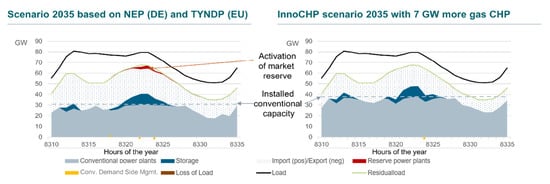
Figure 6.
Comparison of hourly dispatch in base case (left) and InnoCHP scenario (right) for the year 2035. The red area shows the required amount of market reserve power plants. Residual load means electrical load minus non-dispatchable renewable generation.
3.1.2. Increasing Security of Supply with Additional CHP Plants
As described above, additional CHP plants can be an interesting measure to increase the security of supply with an economically viable approach. In a scenario where innovative CHP solutions are applied for all heat sinks that are left from the coal exit, 7 GWel of additional CHP generation is added. In simulations, the effects of these additions on the security supply are analyzed. The required amount of reserve activation and the dependency from import are used for measuring security of supply in this setup.
Effects on Reserve Activation
Figure 3, on the right, shows the effect on the required reserve activation. While, in the base case, there are several hours of market reserve activation (red area in figure on the left), this is not required anymore in the InnoCHP scenario. The installed conventional capacity (including CHP) is increased and combined with the imports in these hours, whereby the required power can be provided in every hour without reserve activation throughout the entire year.
Effects on Imports and Exports
Another aspect indicating the security of supply of a country is the amount of energy that has to be imported. Again, there is a significant impact of adding innovative CHP solutions. Figure 7 on the left, compares the imports and exports to and from the neighboring countries for the base case. The results show an export of 101 TWh and an import of 84 TWh, resulting in Germany still being a net exporter of 17 TWh in 2035. The reason can be seen in the strong increase in renewable generation, especially the high amounts of wind power. When adding the CHP capacities, there will be a further increase in net export from 17 TWh to 36 TWh (109 TWh export vs. 73 TWh import). With the increased generation within Germany, the average electricity spot market price is reduced from 52 EUR/MWh in the base case to 50.7 EUR/MWh in the InnoCHP scenario.
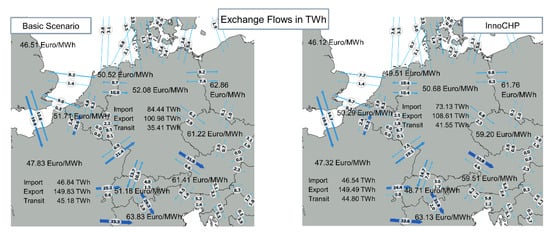
Figure 7.
Market model results: Comparison of annual energy exchange in 2035 between countries and the average electricity price for the base scenario on the left and the InnoCHP on the right.
Effects on Electricity Prices
For a close look at the effects on electricity prices, Figure 8 shows the annual duration curve for both the base and the InnoCHP scenario. The following effects can be observed:
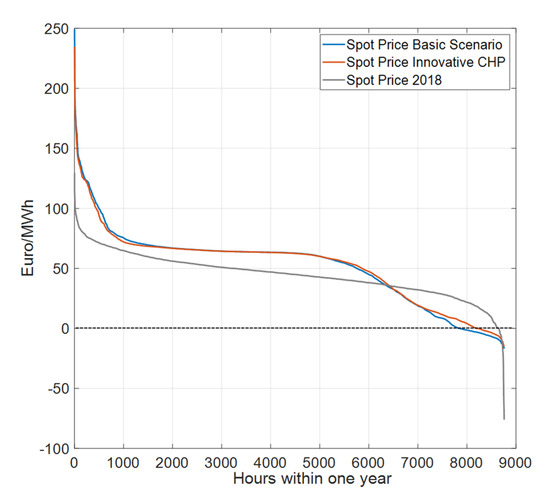
Figure 8.
Annual duration curve of electricity prices in the year 2035. Price are derived in the simulation as described in Section 2.2.2 and based on the parameter assumptions in Section 2.1. The number of negative prices [52] is reduced from 922 in the base scenario to 586 in the InnoCHP scenario.
- -
- Adding CHP plants reduces the peak electricity prices; in particular, the hours with very high prices above 100 EUR/MWh are reduced significantly.
- -
- When it comes to very low and even negative prices, the effect is the other way around; the electric heaters that are installed consume electricity in times with very high renewable generation and, thus, dampen the price curve.
To summarize the effects, adding new innovative CHP solutions including heat pumps or electric heaters flattens the annual duration curve by reducing both very high and very low prices. This can be seen as a positive effect, as volatility is reduced, making the energy market more reliable for both consumers and producers. All simulations are based on weather data of the year 2012. Therefore, we cannot provide the impact of significant changing weather conditions. To quantify the impact of global warming effects in the operation of power plants, additional efforts leaving the scope of this study are necessary.
3.2. Renewable Integration: Congestion Management and Flexibilities
An efficient renewable integration and operation of the power system is a cornerstone of Germany’s energy system transformation. Due to grid congestions, costs for redispatch including those for curtailment of renewable energies are a substantial share in the overall costs of grid operation in Germany. Hence, renewable integration is assessed by the analysis of required congestion management measures using the base scenarios 2023 and 2035, as well as the sensitivities Grid scenario 2023+, NoSuedOstLink, Onshore–Offshore Shift, and GridFlex.
Figure 9 presents the maximum (N-1)-line utilizations in the German electrical transmission grid for the expansion scenarios 2023 and 2023+, as well as the base scenario 2035. In 2023, the lines on the north–south axis of Germany are extensively overloaded due to a strong feed-in of onshore and offshore wind power plants located in the north of Germany. Additionally, transmission capacities between the north and south are missing for power demand centers in the southern part. Within the expansion scenario 2023+, the overloads and the resulting congestion management measures are reduced significantly due to the construction of additional transmission capacities and power flow controlling devices providing additional operational flexibility. In the scenario 2035, extensive overloads occur also on the north–south axis of Germany and are again caused by high renewable penetration in northern Germany. The optimized control of HVDC systems and PSTs avoids additional overloads.
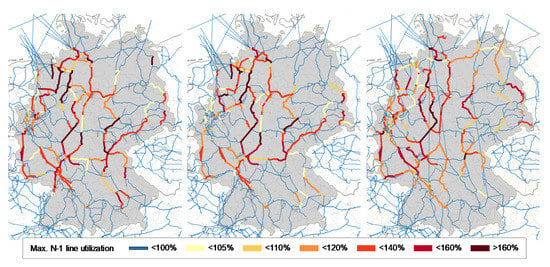
Figure 9.
Maximum (N-1)-line utilizations in the German electrical transmission grid for expansion scenario 2023 (left), scenario 2023+ (center), and scenario 2035 (right).
Resolving all bottlenecks in the scenarios 2023 and 2023+ requires congestion management volumes of 52.6 TWh/a and 29.2 TWh/a, respectively. Spatially resolved congestion management interventions per technology are presented in Figure 10. In particular, curtailment of wind power plants in the northern part of Germany is used for alleviating bottlenecks. To balance the renewable curtailment, feed-in of conventional power plants in the southern part of Germany is increased. The comparison of the expansion scenario 2023 and 2023+ illustrates that congestion management measures are reduced by about 44% due to the construction of additional transmission capacities and power flow controlling devices. Although overloads in 2035 are similarly large to those in 2023, the required congestion management measures for satisfying the N-1 security criterion are reduced significantly to 19.2 TWh/a. Hence, the congestion management volumes are roughly at today’s level. The reduction is enabled by operational flexibility provided by five HVDC systems, as well as several PSTs, which will be placed within the German electrical transmission grid until 2035. Furthermore, power-to-gas units will provide additional flexibilities to avoid the curtailment of offshore wind power feed-in. Remaining bottlenecks are resolved by the curtailment of offshore wind power, as well as ramping up conventional power plants, particularly gas power plants, in the south of Germany.
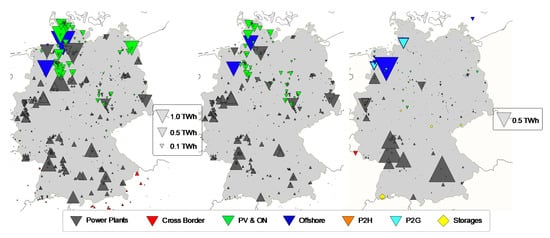
Figure 10.
Spatially resolved congestion management measures for grid expansion scenario 2023 (left), scenario 2023+ (center), and scenario 2035 (right); upward/downward pointing triangles indicate a power increase/decrease.
Preventive congestion management measures taken into account for alleviating bottlenecks are shown for the base scenario 2035, as well as the sensitivities of this scenario, in Figure 11.
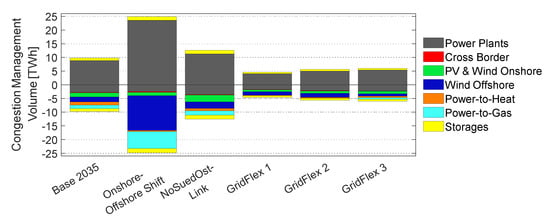
Figure 11.
Preventive congestion management interventions for scenario 2035 and corresponding sensitivities.
3.2.1. Sensitivity Onshore–Offshore Shift
Due to the shift of installed onshore wind power to locations of offshore wind power plants within this sensitivity, the overloads and, hence, the required congestion management volume is significantly increased up to 49.7 TWh/a. Simultaneously, power-to-gas units are utilized to a larger extent to reduce the curtailment of renewable energies. Nevertheless, the grid topology in the northern part of Germany is not designed for transmitting the additional energy, and generation from offshore wind power plants has to be curtailed by 12.7 TWh/a (see Figure 11).
3.2.2. Sensitivity NoSuedOstLink
In the case that the HVDC system SuedOstLink will not be constructed until 2035 (assuming an equal supply task as in the base scenario 2035), the overloads within the meshed AC grid between both planned converter stations will be intensified. Consequently, the total congestion management volume will be increased by about 31% to 25.1 TWh/a. The additional congestion management measures include, in particular, further wind on- and offshore curtailment.
3.2.3. Sensitivity GridFlex
The impact of admitting curative measures on the operation of the power system is analyzed in three scenarios, which investigate central grid boosters (GridFlex 1), decentral flexibility (GridFlex 2), or the curative operation of HVDC systems and PSTs (GridFlex 3). All scenarios show a substantial reduction of the preventive congestion management amount to 9.2 TWh/a (GridFlex 1), 11.4 TWh/a (GridFlex 2), and 12.0 TWh/a (GridFlex 3) with respect to the base case (scenario 2035) of 19.2 TWh/a. Overall, the results show that the savings potential is substantial with reductions of 26–52%. Remarkably, scenario GridFlex 3 (curative operation of HVDC systems and PSTs) shows comparable redispatch reductions using the existing and planned devices in 2035 and does not assume purpose-specific investments into large-scale flexibility-providing technologies such as grid boosters.
The parameter choices (e.g., limiting currents (TATL) by 120% of PATL in both 380 kV and 220 kV lines) directly influence the obtained congestion management savings. The current choices are made in the sense of a potential analysis to show which reductions and related cost savings are in principle possible. These assumptions also allow one to compare the impact of different flexibility sources on congestion management reductions. However, for a real-world implementation of curative operation strategies, further constraints arising from operational constraints, uncertainty in the load and generation forecasts, and the necessity to leave backup margins available will reduce these congestion management savings.
The above analyses investigated the amount of congestion management in the target years 2023 and 2035 with different stages of the network expansion, such as the discontinuation of SuedOstLink, as well as the consequences of replacing onshore wind installation with offshore wind power. Additionally, the potential for efficiency gains when shifting from purely preventive to curative operation strategies was quantified. The results can be summarized as follows:
- Increased congestion management volumes in scenarios 2023 and “NoSuedOstLink” compared to scenario 2023+ and scenario 2035 suggest the importance of a fast implementation of the planned grid expansion measures.
- A shift from onshore to offshore wind installations is possible but entails substantial renewable curtailments due to grid congestions.
- Admitting curative operation strategies helps to substantially reduce congestion management volumes (within the modeled scenario by 26% to 52%).
3.3. System Stability
Conventional generation units with synchronous and asynchronous generators contribute significantly to system stability by providing inertia, short-circuit current, and reactive power reserves. Therefore, the decommissioning of conventional power plants such as coal power plants leads to a significant reduction in ancillary services in the transmission grid. Locally, the shutdown affects rotor angle stability and voltage stability due to resulting deficits in short-circuit power and reactive power reserves, potentially increasing the demand for fully integrated grid components. From a systemwide perspective, the reduced system inertia influences frequency stability in cases of power imbalances by increasing frequency gradients and reducing the frequency containment reserve of the system. However, no critical frequency deviations are to be expected as frequency is a global system property.
The system stability analyses were carried out for the base scenarios and the scenario sensitivities as described above. Most of the scenario sensitivities only have a marginal impact on the stability aspects when applying the presented assessment methods. Therefore, the results below focus on the two base scenarios 2023 and 2035. The reactive power analysis shows additional reactive power demands in various regions, similar to the NEP [1]. Our analysis confirms the need for the related measure to assure reactive power balance.
3.3.1. Short-Circuit Analysis
The subtransient short-circuit power is calculated for both high-voltage () and low-voltage () conditions in the German 380 kV voltage level. We assume a voltage magnitude of 420 kV and 390 kV to determine and , respectively. The resulting short-circuit power values are shown in Figure 12 for both 2023 and 2035. While the maximum values decrease significantly for both and , the median and minimum values remain almost constant. This is caused by two trends:
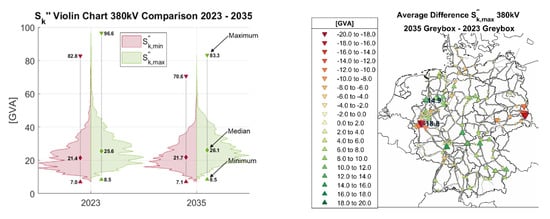
Figure 12.
Distribution of and for 2023 and 2035 (left) and average differences of between 2035 and 2023 in Germany (right).
- The shutdown of lignite power plants reduces the short-circuit power in the western and eastern German lignite regions (Rhineland and Lausitz) by up to 18.8 GVA.
- The construction of HVDC connections increases the short-circuit power, particularly in northwest Germany, by up to 14.9 GVA.
When looking at the relative voltage step for the switching of a typical mechanically switched capacitor bank with a rated power of 300 Mvar, weak points can be identified.
Figure 13 (left) shows that the voltage step is kept below 2% at most western German substations, whereas it exceeds 2% at a high number of eastern German substations. This means that new short-circuit power capacities need to be constructed. Otherwise, the switching of capacitor banks and outages of lines, transformers, or power plants may lead to high voltage steps. These results indicate possible problems for voltage control and stability and should be analyzed by means of detailed time-domain simulations.
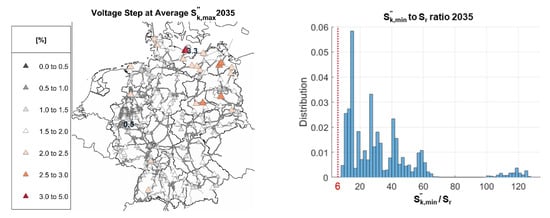
Figure 13.
Relative voltage steps at average for 2035 in Germany assuming a reactive power step of 300 Mvar (left) and histogram of short-circuit power ratio for 2035 (right).
The rotor angle stability is analyzed by comparing the accumulated rated power of synchronous machines at each point of common coupling to its minimal short-circuit power. Only machines with a rated power of at least 100 MVA are considered, as the loss of smaller power plants does not endanger the system stability of the European transmission grid. The minimal ratio is determined to 8.6 and is, thus, well above the minimal value of 6. Hence, we can conclude that the rotor angle stability is not endangered for the considered scenario in 2035.
3.3.2. Inertia Analysis
To assess the impact of a German coal exit on frequency stability of the European power system, the acceleration time constant of the grid is calculated for all hours of the considered scenarios. Figure 14 gives an overall summary of the resulting inertia values of both scenarios, as well as a spatial resolution of the contribution of each country of the ENTSO-E continental Europe region (CE) in hour 4741 of scenario 2035, which is the hour with the lowest value.
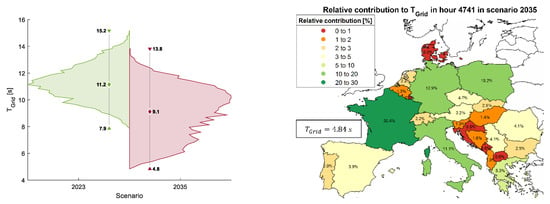
Figure 14.
for scenarios 2023 and 2035 (left) and each of the continental Europe (CE) region countries’ contribution to system inertia for hour 4741 with lowest overall system inertia (right).
For the base scenario 2023, the median value of is equal to 11.2 s with values ranging from 7.9 s to 15.2 s. This reduction in the grid acceleration constant is negligible regarding the impact on the RoCoF. For base scenario 2035, with a median value of 9.1 s, is reduced to 4.8 s for hour 4741. In this case, Germany contributes 12.9% to the overall grid acceleration constant. This translates to a maximum rate of change in frequency of 0.0816 Hz/s regarding the reference incident for continental Europe in this specific scenario. Therefore, no critical frequency deviations are to be expected as a result of the reduced inertia when investigating the reference power imbalance of 3000 MW for continental Europe.
3.4. Renewable Extension in Germany
The years 2018 and 2019 showed a sharp decline in the additions for onshore wind power plants in Germany (Figure 15). Thus, the German target to reach a 65% share of renewable sources in the annual electricity production in the year 2030 will probably not be achieved without any compensation. A measure that involves only a limited number of stakeholders would be an accelerated development of offshore wind production. Since offshore wind power feeds in at a few grid connection points near the North Sea and Baltic coast (far from the majority of load centers), we have to analyze potential network congestion caused by additional offshore wind capacity.
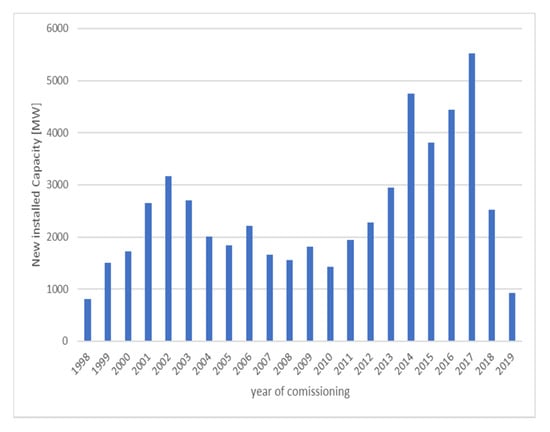
Figure 15.
Historical additions for onshore wind power plants in Germany.
In this study, we considered an additional 10 GW of offshore wind, resulting in 33 GW total capacity as a sensitivity to our reference scenario for 2035. To model the lagging onshore additions, we reduced in parallel the total onshore capacity from 91 GW, as set in the reference scenario for 2035, to 72 GW. With the underlying weather data from 2012 and the wind turbine characteristics, this results in a shift of 43 TWh yearly electricity generation from onshore to offshore wind.
To mitigate the expected congestion in the transmission system, we doubled, within this sensitivity, the capacity for electrolyzers to 6 GW compared to the reference case taken from the scenario B 2035 of German network development plan [1]. This 6 GW total capacity results from the regional distribution of electrolyzers depicted in Figure 16. That distribution was calculated through minimizing the total system costs assuming no further grid extensions, as described in Section 2.2.7. Since our model feeds the hydrogen produced into the natural gas network for storage and re-electrification, we had to limit the blending of hydrogen to a maximum share. From the literature [56], we took a maximum share of 10% hydrogen per volume.
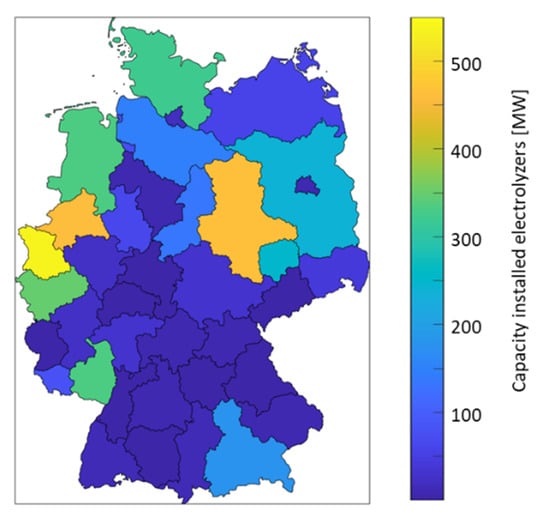
Figure 16.
Regional distribution of electrolyzers.
Due to the definition of the sensitivity with unchanged annual wind generation, we do not see substantial changes in the results of the market simulation compared to the reference scenario. The relevant differences occur in the network simulation, especially with respect to the grid congestion and required redispatch. If the decelerated onshore extension is compensated for via an increased offshore wind generation until 2035, we see that the maximum line utilization in case of N-1 equipment outages shows more critical transmission lines (see Figure 17). The maximum (N-1)-line utilization serves as an input to our simulation of the preventive redispatch and renewable feed-in management that modify the market schedules to resolve network congestions. As a result, we expect an annual volume of 50 TWh for redispatch and feed-in management. Compared to the reference scenario for 2035 with 20 TWh, this more than doubles. The disaggregation of the annual volume to the flexibility providers, such as conventional and renewable power plants, electricity storages, cross-border redispatch, or controllable loads (power to heat and electrolyzers), is shown in Figure 18; even with a total capacity of 6 GW electrolyzers, serving as demand side flexibility, the congestion caused by offshore wind cannot be compensated for.
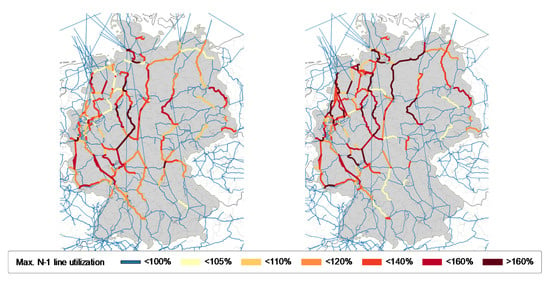
Figure 17.
The maximum line utilization in case of N-1 equipment outages: (left) picture shows reference scenario 2035, and (right) picture shows the sensitivity with increased offshore wind.
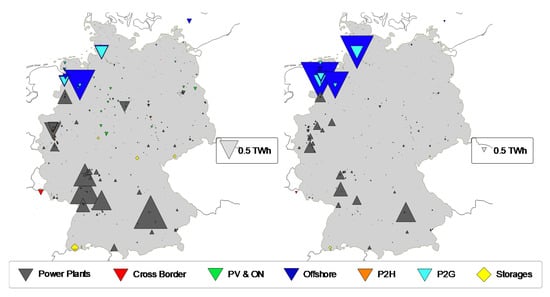
Figure 18.
Distribution of redispatch and feed-in management: (left) picture shows reference scenario 2035, and (right) picture shows the sensitivity with increased offshore wind. A downward triangle indicates an increased operation of power-to-gas (P2G) or power-to-heat (P2H) units, whereby electrical energy is ejected from the electrical transmission grid.
The utilization of the electrolyzers results from their economic dispatch if the value of the produced hydrogen exceeds the operational cost and the flexibility request from congestion management. For the re-electrification use case, we assume that the hydrogen value is given by the natural gas price plus the avoided CO2 emission costs. The averaged full-load hours result in 2800 full-load hours per year. If we force the model to include more than the 6 GW total capacity for electrolyzers, the utilization would decrease, and the profitability seems to be far off.
3.5. Defossilization of German Energy Sector
3.5.1. Impact of CO2 Pricing
As described in Section 2.1, the CO2 emission costs in the reference scenario for 2023 and 2035 are based on the assumptions of the German network development plan [1]. Since these values are at the lower end of current outlooks, we added a sensitivity with, compared to the base scenario, increased CO2 emission costs of 40 EUR/t in 2023 and 100 EUR/t in 2035, which are within the corridor suggested by the international high-level commission on carbon pricing [28].
When analyzing the resulting power plant dispatch or utilization of storage and demand side flexibility, we have to keep in mind that the electricity sector is already decarbonized to a substantial extent. Therefore, we do see limited changes in the European dispatch for 2035, as depicted in Figure 19. Nevertheless, lignite and hard coal-fired power plants which have the highest specific CO2 emissions reduce their generation significantly. The remaining use is largely driven by heating obligations.
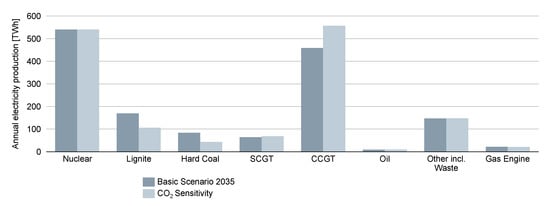
Figure 19.
Comparison of annual generation in Europe for base scenario and increased CO2 prices (see Section 2.1.2. Further Sensitivities) in 2035.
3.5.2. Future Energy Region Lausitz in 2030
The Lausitz region was chosen to depict a transition from a formerly lignite coal-dominated region into a future renewable region that is supplying green hydrogen to the local industry. As costs for the energy system design on a local level are largely determined by the “use of the hydrogen” in light of the specific application, we stress that depicting the industrial hydrogen use is only one option for the Lausitz region, while others may yet need to be explored (the multi-usability of hydrogen offers various supply chain structures and energy system designs where different target prices may be applicable, e.g., for H2 use in the mobility sector). Nevertheless, the Lausitz region features overall favorable conditions for a technology shift due to its renewable potential and local hydrogen demand. A phase-out of the 6 GW coal plants within that region will translate in emission savings of 59 million tons of CO2 annually (equal to 7% of total German CO2 in 2017 [12]).
As a result, the benchmarking production price for green hydrogen is between 7 and 9.1 ct/kWh, whereas values toward the lower bound of that range imply more solar plant installations compared to wind farms within the Lausitz region. Such a static production “price tag” must be benchmarked against a conventional steam methane reforming price. Estimating the steam methane reforming production price requires natural gas price estimates and certificate prices for 2030, which were determined in Section 2.1, as well as the technical parameters of the technology itself [50]. Our analysis shows that the chosen green field approach for a green hydrogen route with favorable grid topology and an existing H2 demand for industrial usage remains challenging in the Lausitz region. Our results also show that production costs for conventional H2 production via steam methane reforming are at 5.2 ct/kWh, being 2 ct/kWh lower than the minimum price for green hydrogen. In a forward-looking manner, this implies that capital expenditures for electrolyzers would need to halve to create a competitive environment for the green industrial hydrogen use within the Lausitz region. As an alternative to investment cost reduction for the electrolyzer, CO2 certificate prices surpassing a value of 140 EUR/tCO2 are making green hydrogen more attractive compared to the conventional steam methane reforming process.
As these numbers are only indicative, we suggest further studying the multi-usability of hydrogen in a regional context. Our analysis reveals, not surprisingly, that the production cost is highly dependent on the region, its achievable full-load hours, renewable potential, and the use of hydrogen for the specific application.
4. Summarizing Discussion of Results
It can be seen that the changes in generation due to the coal exit have significant effects on the energy system. Germany’s systemic balance has so far been characterized by a strong export surplus. As a consequence of the coal phase-out, this surplus will decline significantly but Germany will still remain a net exporter in 2035. The authors of [8] even see Germany as a net importer in 2030 and [10] in 2035. Nevertheless, dependencies in the European electricity market will increase even if the results of this study show that security of supply is maintained. Therefore, the use of reserve power plants might be temporarily required. Additional gas power plants with CHP can increase the security of supply and optimize the heat supply. All market studies agree that electricity prices will rise strongly. In addition to the change in generation capacity, the development of the CO2 certificate price is a key reason for that. The CO2 pricing can be decisive for the overall market, which was also shown in [11].
The analysis of the transmission grid operation investigated the amount of congestion management in the target years 2023 and 2035 with different stages of the network expansion. Increased congestion management volumes in the scenarios 2023 and “NoSuedOstLink” compared to scenario 2023+ and scenario 2035, respectively, suggest the importance of a fast implementation of the planned grid expansion measures. The analysis of replacing onshore wind installations with offshore wind power shows that a shift from onshore to offshore wind is possible but entails substantial renewable curtailments due to upcoming grid congestions. Additionally, the potential for efficiency gains when shifting from purely preventive to curative operation strategies was quantified within the simulations. Admitting curative operation strategies helps to substantially reduce congestion management volumes. Thus, the potential of curative operation strategies proposed and identified by previous works such as [35] or [57] is confirmed by this study.
The coal exit also has several implications for the system stability. Regarding voltage stability, a substantial amount of steady-state and dynamic reactive power reserves is lost. Consequently, the short-circuit power level is decreased in the German lignite regions, and new short-circuit power sources need to be allocated, particularly in the Lausitz region. However, the short-circuit power level remains sufficient to ensure rotor angle stability. On the other hand, the increasing number of HVDC connections for offshore wind power leads to increasing reactive power reserves in northern Germany. When analyzing frequency stability, it becomes apparent that the inertia remains at a sufficient level for the considered scenarios in 2023 and 2035. Hence, we are able to confirm the results shown for the 2030 scenario in [4], which also indicate a sufficient inertia for the European transmission grid. This may, however, change if more and more countries in continental Europe decide to shut down their coal or nuclear power plants.
In contrast to other studies, this study only analyzed predefined scenarios with respect to the network expansion. The scenarios here do not reflect an optimized transition pathway as in [8] or [10]. Instead, the scenarios show a likely realization of political targets on the basis of current planning processes of the European energy system. The focus is on a detailed simulation of market and grid operations. To this end, perfect foresight is assumed. Uncertainties that can influence decision-making behavior, especially at the local level as Mrówczyńska et al. showed in [58], are not considered. The methodical approach for power flow and redispatch simulations matches the approach used by the German TSOs in [1]. On the contrary, system stability was only assessed by simplified approaches and not based on detailed time-domain simulations, which were carried out in [1]. This means that this study was able to indicatively analyze the stability of the discussed scenarios. However, since a more realistic transmission grid model was used, this study reached a higher level of detail than in [4], which only used a simplified grid model.
5. Conclusions and Outlook
The in-depth analysis performed confirms that the phase-out of conventional capacity (coal and nuclear power plants), alongside simultaneously ramping up renewable generation as planned for Germany, is generally feasible without increasing the risk of load shedding and blackouts. Despite the projected firm capacity of 51 GW being below peak load of 82 GW in 2035, the European electricity market will ensure the security of supply. However, it should be noted that only specific scenarios were examined and no stochastic analysis was carried out. Moreover, with the enforcement of decarbonization currently discussed in the Green Deal, the 2035 results should be reassessed as soon as the updated national and European plans are available, since a stronger switch to renewable generation all over Europe will increase the simultaneity compared to today’s planning base. According to our base scenario, Germany contributes in 2035 less than 13% to the overall European grid acceleration constant, resulting in a RoCoF of 0.0816 Hz/s, regarding the reference incident for continental Europe with 3 GW power imbalance. Thus, the system stability analysis reveals no major issues that would be roadblocks for the planned phase-out; however, a number of voltage stability issues were identified and need to be addressed to ensure the reliability of the system. These issues must be analyzed in detail by time-domain simulations, since the validity of our results is limited by the simplified assessment based on short-circuit and power flow calculations. However, this type of study requires more detailed component models, such as real power plant models including turbine, exciter, and governor, which are not publicly available.
From the detailed results, the authors would like to highlight the positive role of adding 7 GW innovative CHP, the importance of a network congestion management, and the essential network extension plans: (1) Innovative concepts for hybrid CHP plants can help to secure heat and electricity demand without thwarting the overall CO2 reduction plans. (2) Network congestion will be ubiquitous, and its management requires flexibilities from sector coupling. Flexibility-based congestion management shows substantial savings potential with reductions of 26–52%. (3) Existing network expansion plans must be implemented on time to support the critical phase around nuclear phase-out and first phase of coal exit in Germany (2023 modeling).
Comparing the historic annual amount of energy for redispatch and related measures, e.g., 20 TWh in 2019 (see the monitoring report of German regulator [52]), with our projected values in Section 3.2, it becomes clear that network congestion and reduced security margins will become the new normal. We conclude that future energy systems require expanded flexibilities in combination with forward planning operation strategies. Reduced security margins also indicate that system stability may be at risk and must be considered as a significant constraint in future energy system studies.
Work in this paper focuses on the German energy system embedded into the European context. The installed energy mix in other countries is not optimized. To extend this scope, Siemens and RWTH Aachen joined the HORIZON 2020 funded project “plan4res” [58], which focuses on the pan-European energy system by modeling it as an integrated energy system of coupled national systems. By considering all relevant energy-consuming sectors, the impact of sectors beyond electricity, i.e., heating and cooling, mobility, and fuels and gas, and the impact of sector coupling on the energy system can be analyzed in detail. In an adjunct case study, sector coupling revealed itself as a core element to reduce the overall CO2 emissions. Description of the model interactions of the plan4res framework and of the scope of the case study can be found in [59,60,61]; detailed results are to be published in early 2021.
Author Contributions
Conceptualization, C.M., D.M., H.J.H., L.W., M.D., M.F., M.H., M.K. (Markus Knittel), M.K. (Martin Kueppers), M.M., S.P., and T.K.; methodology, C.M., D.M., H.J.H., L.W., M.D., M.F., M.H., M.K. (Markus Knittel), M.K. (Martin Kueppers), M.M., S.P., and T.K.; validation, C.M., D.M., H.J.H., L.W., M.D., M.F., M.H., M.K. (Markus Knittel), M.K. (Martin Kueppers), M.M., S.P., and T.K.; investigation, C.M., D.M., H.J.H., L.W., M.D., M.F., M.H., M.K. (Markus Knittel), M.K. (Martin Kueppers), M.M., S.P., and T.K.; data curation, C.M., D.M., H.J.H., L.W., M.D., M.F., M.H., M.K. (Markus Knittel), M.K. (Martin Kueppers), M.M., S.P., and T.K.; writing—original draft preparation, C.M., D.M., H.J.H., L.W., M.D., M.F., M.H., M.K. (Markus Knittel), M.K. (Martin Kueppers), M.M., S.P., and T.K.; writing—review and editing, C.M., D.M., H.J.H., L.W., M.D., M.F., M.H., M.K. (Markus Knittel), M.K. (Martin Kueppers), M.M., S.P., and T.K.; visualization, C.M., D.M., H.J.H., L.W., M.D., M.F., M.H., M.K. (Markus Knittel), M.K. (Martin Kueppers), M.M., S.P., and T.K.; supervision, A.M. and S.N.; project administration, M.M. All authors have read and agreed to the published version of the manuscript.
Funding
This research received no external funding.
Institutional Review Board Statement
Not applicable.
Informed Consent Statement
Not applicable.
Data Availability Statement
The data presented in this study are given in the text above or available in the given references.
Conflicts of Interest
The authors declare no conflict of interest.
Abbreviations
| AC | Alternating current |
| BMWi | Bundesministerium für Wirtschaft und Energy (German Federal Ministry) |
| CE | Continental Europe |
| CHP | Combined heat and power |
| CO2 price | Scenario with higher CO2 prices |
| CTS | Commercial, trade, and services |
| DC | Direct current |
| DENA | Deutsche Energieagentur (German Energy Agency) |
| EEG | German Renewable Energy Sources Act |
| EMMS | European multimodal market simulation |
| ENTSO-E | European Network of Transmission System Operators for Electricity |
| ESDP | Energy System Development Planner |
| EWI | Energiewirtschaftliches Institut (Institute of Energy Economics) |
| GIS | Geographic Information System |
| Grid 2023+ | Scenario with grid projects planned until end 2023 |
| GridFlex | Scenario with flexible grid operation |
| GVA | Gigavolt-ampere |
| GW | Gigawatt |
| HVDC | High-voltage direct current |
| InnoCHP | Scenario with innovative CHP approach |
| LODF | Line outage distribution factors |
| MAF | Midterm Adequacy Forecast |
| MILP | Mixed-integer linear programming |
| MVA | Megavolt-ampere |
| Mvar | Megavolt-ampere reactive |
| MWh | Megawatt-hour |
| NEP | Netzentwicklungsplan (German grid development plan) |
| NoSuedOstLink | Scenario with delayed HVDC link in Germany |
| NTC | Net transfer capacity |
| NUTS | Nomenclature of Territorial Units for Statistics |
| PATL | Permanently admissible transmission loading |
| PSDF | Phase shifting distribution factors |
| PST | Phase shifting transformer |
| PTDF | Power transfer distribution factors |
| PV | Photovoltaics |
| RoCoF | Rate of change in frequency |
| RWTH | Rheinisch-Westfälische Technische Hochschule (Technical University) |
| STATCOM | Static synchronous compensator |
| SuedOstLink | HVDC link from north to southeast Germany |
| TATL | Temporarily admissible transmission loading |
| TWh | Terawatt-hour |
| TYDNP | Ten-Year Network Development Plan |
References
- 50Hertz Transmission, Amprion, TenneT TSO, TransnetBW. Netzentwicklungsplan Strom 2030, Version 2019. In Zweiter Entwurf der Übertragungsnetzbetreiber; 2019; Available online: https://www.netzentwicklungsplan.de/ (accessed on 21 January 2021).
- Bundesministerium für Wirtschaft und Energie. Kommission Wachstum, Strukturwandel und Beschäftigung. In Abschlussbericht; 2019; Available online: https://www.netzentwicklungsplan.de/ (accessed on 21 January 2021).
- European Comission. National Energy and Climate Plans (NECPs). Available online: https://ec.europa.eu/energy/topics/energy-strategy/national-energy-climate-plans_en (accessed on 22 March 2019).
- Deutsche Energie-Agentur. Dena-Studie Systemsicherheit 2050. Available online: https://www.dena.de/fileadmin/dena/Publikationen/PDFs/2020/dena_Systemsicherheit_2050_LANG_WEB.pdf (accessed on 21 January 2021).
- Umweltbundesamt. Datenbank Kraftwerke in Deutschland. Available online: https://www.umweltbundesamt.de/dokument/datenbank-kraftwerke-in-deutschland (accessed on 22 March 2019).
- Oei, P.-Y.; Kendziorski, M.; Herpich, P.; Kemfert, C.; von Hirschhausen, C. Klimaschutz statt Kohleschmutz: Woran es beim Kohleausstieg Hakt und Was zu Tun Ist; Bund für Umwelt und Naturschutz Deutschland (BUND): Berlin, Germany, 2020. [Google Scholar]
- Bartholdsen, H.-K.; Eidens, A.; Löffler, K.; Seehaus, F.; Wejda, F.; Burandt, T.; Oei, P.-Y.; Kemfert, C.; Hirschhausen, C. Pathways for Germany’s Low-Carbon Energy Transformation towards 2050. Energies 2019, 12, 2988. [Google Scholar] [CrossRef]
- Kittel, M.; Goeke, L.; Kemfert, C.; Oei, P.-Y.; von Hirschhausen, C. Scenarios for Coal-Exit in Germany—A Model-Based Analysis and Implications in the European Context. Energies 2020, 13, 2041. [Google Scholar] [CrossRef]
- Matthes, C.; Hermann, H.; Loreck, C.; Mendelevitch, R.; Cook, V. Die deutsche Kohle-Verstromung bis 2030. In Eine modellgestützte Analyse der Empfehlungen der Kommission, Wachstum, Strukturwandel und Beschäftigung; Öko-Institut e.V.: Berlin, Germany, 2019. [Google Scholar]
- EWI. Auswirkungen einer Beendigung der Kohleverstromung bis 2038 auf den Strommarkt, CO2-Emissionen und ausgewählte Industrien. Eine Analyse des Abschlussberichtsder WSB-Kommission. In Auftrag des Ministeriums für Wirtschaft, Innovation, Digitalisierung und Energie des Landes Nordrhein-Westfalen—Endbericht, August 2019, Überarbeitete Fassung, Mai 2020; EWI: Köln, Germany, 2020. [Google Scholar]
- Keles, D.; Yilmaz, H.Ü. Decarbonisation through coal phase-out in Germany and Europe—Impact on Emissions, electricity prices and power production. Energy Policy 2020, 141, 111472. [Google Scholar] [CrossRef]
- Oei, P.-Y.; Lorenz, C.; Schmalz, S.; Brauers, H.; Herpich, P.; von Hirschhausen, C.; Kemfert, C.; Dröschel, B.; Hildebrand, J.; Horst, J.; et al. Klimaschutz und Kohleausstieg: Politische Strategien und Maßnahmen bis 2030 und darüber hinaus. In Abschlussbericht; Umweltbundesamt: Dessau-Roßlau, Germany, 2019. [Google Scholar]
- EWI; ef.Ruhr GmbH. Entwicklung der Momentanreserve und Abschätzung des Bedarfes an Fast Frequency Response im Europäischen Verbundsystem. Studie im Auftrag der Siemens AG; EWI: Köln, Germany, 2020. [Google Scholar]
- Hladik, D.; Fraunholz, C.; Kühnbach, M.; Manz, P.; Kunze, R. Insights on Germany’s Future Congestion Management from a Multi-Model Approach. Energies 2020, 13, 4176. [Google Scholar] [CrossRef]
- Bundesnetzagentur. Kraftwerksliste. Available online: https://www.bundesnetzagentur.de/DE/Sachgebiete/ElektrizitaetundGas/Unternehmen_Institutionen/Versorgungssicherheit/Erzeugungskapazitaeten/Kraftwerksliste/kraftwerksliste-node.htm (accessed on 22 March 2019).
- Bundesministerium für Wirtschaft und Energie (BMWi). Kommission Wachstum, Strukturwandel und Beschäftigung—Abschlussbericht; Bundesministerium für Wirtschaft und Energie: Berlin, Germany, 2019. [Google Scholar]
- EWI; GWS; Prognos. Entwicklung der Energiemärkte—Energiereferenzprognose; Bundesministeriums für Wirtschaft und Technologie: Berlin, Germany, 2014. [Google Scholar]
- ENTSO-E. Mid-Term Adequacy Forecast 2018; ENTSO-E: Brussels, Belgium, 2018. [Google Scholar]
- ENTSO-E. Ten Year Network Development Plan (TYNDP) 2018; ENTSO-E: Brussels, Belgium, 2018. [Google Scholar]
- France Government. Programmations Pluriannuelles de L’énergie; France Government: Paris, France, 2019.
- ENTSO-E. Transparency Platform. Available online: https://transparency.entsoe.eu/ (accessed on 22 March 2019).
- IHS Markit. IHS Long-Term Planning and Energy Scenarios—IHS Energy Rivalry; IHS Markit: London, UK, 2018. [Google Scholar]
- 50Hertz Transmission, Amprion, TenneT TSO, TransnetBW. Netzentwicklungsplan Strom 2012; Zweiter Entwurf der Übertragungsnetzbetreiber, 2012; Available online: https://www.netzentwicklungsplan.de/ (accessed on 21 January 2021).
- 50Hertz Transmission, Amprion, TenneT TSO, TransnetBW. Netzentwicklungsplan Strom 2013; Zweiter Entwurf der Übertragungsnetzbetreiber, 2013; Available online: https://www.netzentwicklungsplan.de/ (accessed on 21 January 2021).
- 50Hertz Transmission, Amprion, TenneT TSO, TransnetBW. Netzentwicklungsplan Strom 2014; Zweiter Entwurf der Übertragungsnetzbetreiber, 2014; Available online: https://www.netzentwicklungsplan.de/ (accessed on 21 January 2021).
- 50Hertz Transmission, Amprion, TenneT TSO, TransnetBW. Netzentwicklungsplan Strom 2025; Zweiter Entwurf der Übertragungsnetzbetreiber, 2015; Available online: https://www.netzentwicklungsplan.de/ (accessed on 21 January 2021).
- 50Hertz Transmission, Amprion, TenneT TSO, TransnetBW. Netzentwicklungsplan Strom 2030, 2017; Zweiter Entwurf der Übertragungsnetzbetreiber, 2017; Available online: https://www.netzentwicklungsplan.de/ (accessed on 21 January 2021).
- High-Level Commission on Carbon Prices. Report of the High-Level Commission on Carbon Prices. 2017. Available online: https://www.carbonpricingleadership.org/report-of-the-highlevel-commission-on-carbon-prices (accessed on 22 September 2020).
- Kollenda, K.; Hoffrichter, A.; Schneider, M.; Moser, A. Planungsorientierte Simulation kurativer Maßnahmen im Deutschen Übertragungsnetz. In 16. Symposium Energieinnovation; pp. 1–12. Available online: https://www.tugraz.at/fileadmin/user_upload/tugrazExternal/4778f047-2e50-4e9e-b72d-e5af373f95a4/files/lf/Session_D1/415_LF_Kollenda.pdf (accessed on 7 October 2020).
- Bizz Energy. Abstand von der Energiewende. Available online: https://bizz-energy.com/abstand_von_der_energiewende (accessed on 18 June 2020).
- Müller, C.; Hoffrichter, A.; Wyrwoll, L.; Schmitt, C.; Trageser, M.; Kulms, T.; Beulertz, D.; Metzger, M.; Duckheim, M.; Huber, M.; et al. Modeling framework for planning and operation of multi-modal energy systems in the case of Germany. Appl. Energy 2019, 250, 1132–1146. [Google Scholar] [CrossRef]
- Raths, S.; Koopmann, S.; Müller, C.; Meinerzhagen, A.K.; Falke, T.; Cramer, M.; Kulms, T.; Beulertz, D.; Barrios, H.; Schnettler, A.; et al. The Energy System Development Plan (ESDP). In ETG Congress; VDE: Bonn, Germany, 2015. [Google Scholar]
- Raths, S. Marktsimulationsverfahren für Einen Dezentral Geprägten Strommarkt. Ph.D. Thesis, RWTH Aachen University, Aachen, Germany, October 2019. [Google Scholar]
- Natemeyer, H. Modellierung der Betriebsführung elektrischer Übertragungsnetze für Netzplanungsprozesse. Ph.D. Thesis, RWTH Aachen University, Aachen, Germany, March 2017. [Google Scholar]
- Hoffrichter, A.; Kollenda, K.; Schneider, M.; Puffer, R. Simulation of Curative Congestion Management in Large-Scale Transmission Grids. In Proceedings of the 54th International Universities Power Engineering Conference (UPEC), Bucharest, Romania, 3–6 September 2019. [Google Scholar]
- Kundur, P.; Paserba, J.; Ajjarapu, V.; Andersson, G.; Bose, A.; Canizares, C.; Hatziargyriou, N.; Hill, D.; Stankovic, A.; Taylor, C.; et al. Definition and classification of power system stability IEEE/CIGRE joint task force on stability terms and definitions. IEEE Trans. Power Syst. 2004, 19, 1387–1401. [Google Scholar] [CrossRef]
- ENTSO-E. Frequency Stability Evaluation Criteria for the Synchronous Zone of Continental Europe: Requirements and Impacting Factors. RG-CE SYSTEM Protection & Dynamics Sub Group. Available online: https://www.entsoe.eu/Documents/SOC%20documents/RGCE_SPD_frequency_stability_criteria_v10.pdf (accessed on 21 September 2020).
- ENTSO-E. Rate of Change of Frequency (RoCoF) Withstand Capability: ENTSO-E Guidance Document for National Implementation for Network Codes on Grid Connection. Available online: https://eepublicdownloads.azureedge.net/clean-documents/Network%20codes%20documents/NC%20RfG/IGD_RoCoF_withstand_capability_final.pdf (accessed on 21 September 2020).
- IEC. Part 0: Calculation of currents (60909-0:2016). In Short-Circuit Currents in Three-Phase a.c. Systems; IEC: Genève, Switzerland, 2016. [Google Scholar]
- 50Hertz Transmission GmbH; Amprion GmbH; Tennet TSO GmbH; TransnetBW GmbH. Grundsätze für Die Planung des Deutschen Übertragungsnetzes. Available online: https://www.amprion.net/Dokumente/Netzplanungsgrunds%C3%A4tze/2018.09.10_Update_%C3%9CNB-PlGrS_final_gesch%C3%BCtzt.pdf (accessed on 21 January 2021).
- Beer, M.; Huber, M.; Mauch, W. Flexible Operation of Cogeneration Plants—Chances for the Integration of Renewables. In Proceedings of the 11th IAEE Conference, Vilnius, Litauen; 2010. Available online: http://mediatum.ub.tum.de/doc/1210549/241380.pdf (accessed on 21 January 2021).
- Kryzia, D.; Kopacz, M.; Kryzia, K. The Valuation of the Operational Flexibility of the Energy Investment Project Based on a Gas-Fired Power Plant. Energies 2020, 13, 1567. [Google Scholar] [CrossRef]
- Klaus Stratmann. Energiewende—Lichtblicke für die Kohle-Reviere. Handelsblatt 2019, 25, 11. [Google Scholar]
- BMWi. Projektbericht, Erneuerbare Energien-Vorhaben in den Tagebauregionen. Available online: https://www.erneuerbare-energien.de/EE/Redaktion/DE/Downloads/Berichte/erneuerbare-energien-vorhaben-in-den-tagebauregionen.pdf?__blob=publicationFile&v=4 (accessed on 29 September 2020).
- Fraunhofer IEE. Windmonitor: Entwicklung der Onshore-Volllaststunden für Gesamtdeutschland. Available online: http://windmonitor.iee.fraunhofer.de/windmonitor_de/3_Onshore/5_betriebsergebnisse/1_volllaststunden/ (accessed on 29 September 2020).
- Brynolf, S.; Taljegard, M.; Grahn, M.; Hansson, J. Electrofuels for the transport sector: A review of production costs. Renew. Sustain. Energy Rev. 2018, 81, 1887–1905. [Google Scholar] [CrossRef]
- Tremel, A.; Wasserscheid, P.; Baldauf, M.; Hammer, T. Techno-economic analysis for the synthesis of liquid and gaseous fuels based on hydrogen production via electrolysis. Int. J. Hydrogen Energy 2015, 40, 11457–11464. [Google Scholar] [CrossRef]
- Fraunhofer ISE. Stromgestehungskosten für Erneuerbare Energien; Fraunhofer ISE: Freiburg im Breisgau, Germany, 2018. [Google Scholar]
- Joskow, P.L. Comparing the Costs of Intermittent and Dispatchable Electricity Generating Technologies. Am. Econ. Rev. 2011, 101, 238–241. [Google Scholar] [CrossRef]
- DLR. Langfristszenarien und Strategien für den Ausbau der Erneuerbaren Energien in Deutschland bei Berücksichtigung der Entwicklung in Europa und Global. Schlussbericht. 2012. Available online: https://www.dlr.de/dlr/Portaldata/1/Resources/bilder/portal/portal_2012_1/leitstudie2011_bf.pdf (accessed on 29 September 2020).
- Agora Energiewende. Die Ökostromlücke, ihre Effekte und Wie Sie Gestopft Werden Kann. Available online: https://www.agora-energiewende.de/presse/neuigkeiten-archiv/wie-die-oekostromluecke-gestopft-werden-kann/ (accessed on 21 January 2021).
- Bundesnetzagentur für Elektrizität, Gas, Telekommunikation, Post und Eisenbahnen. Quartalsbericht zu Netz- und Systemsicherheitsmaßnahmen Gesamtjahr und Viertes Quartal 2017. Available online: https://www.bundesnetzagentur.de/DE/Sachgebiete/ElektrizitaetundGas/Unternehmen_Institutionen/Versorgungssicherheit/Netz_Systemsicherheit/Netz_Systemsicherheit.html (accessed on 21 January 2021).
- Gasunie Deutschland and TenneT TSO GmbH. Phase 2—Pathways to 2050. Available online: https://www.tennet.eu/de/news/news/gasunie-und-tennet-klimapolitische-ziele-lassen-sich-nur-mit-einem-integrierten-europaeischen-energi/ (accessed on 21 January 2021).
- Kolster, T.; Krebs, R.; Niessen, S.; Duckheim, M. The contribution of distributed flexibility potentials to corrective transmission system operation for strongly renewable energy systems. Appl. Energy 2020, 279, 115870. [Google Scholar] [CrossRef]
- ENTSO-E. Statistical Fact Sheet 2018, Provisional Values as of 5 June 2019. Available online: https://docstore.entsoe.eu/Documents/Publications/Statistics/Factsheet/entsoe_sfs2018_web.pdf (accessed on 9 November 2020).
- IEA. Current Limits on Hydrogen Blending in Natural Gas Networks and Gas Demand per Capita in Selected Locations. Available online: https://www.iea.org/data-and-statistics/charts/current-limits-on-hydrogen-blending-in-natural-gas-networks-and-gas-demand-per-capita-in-selected-locations (accessed on 22 September 2020).
- Eickmann, J. Simulation der Engpassbehebung im Deutschen Übertragungsnetzbetrieb. Ph.D. Thesis, RWTH Aachen University, Aachen, Germany, September 2015. [Google Scholar]
- Charousset, S. Plan4res: Synergistic Approach of Multi-Energy Models for an European Optimal Energy System Management Tool. Available online: https://www.plan4res.eu/ (accessed on 13 December 2020).
- Beulertz, D.; Charousset, S.; Most, D.; Giannelos, S.; Yueksel-Erguen, I. Development of a Modular Framework for Future Energy System Analysis. In Proceedings of the 54th International Universities Power Engineering Conference (UPEC), Bucharest, Romania, 3–6 September 2019. [Google Scholar] [CrossRef]
- Most, D.; Giannelos, S.; Yueksel-Erguen, I.; Beulertz, D.; Haus, U.-U.; Charousset-Brignol, S.; Frangioni, A. A Novel Modular Optimization Framework for Modelling Investment and Operation of Energy Systems at European Level; ZIB-Report—20-08; Zuse Institute: Berlin, Germany, 2020. [Google Scholar]
- Beulertz, D.; Most, D.; Franken, M.; Oudjane, N.; van Ackooij, W.; Schweiger, J.; Konstantelos, I.; Djapic, P.; Pudjianto, D. Synergistic Approach of Multi-Energy Models for an European Optimal Energy System Management Tool: Deliverable D3.1: Description of model interconnections. Available online: https://www.plan4res.eu/wp-content/uploads/2019/02/D3.1-ModeslsInterconnections_Summary.pdf (accessed on 10 May 2020).
Publisher’s Note: MDPI stays neutral with regard to jurisdictional claims in published maps and institutional affiliations. |
© 2021 by the authors. Licensee MDPI, Basel, Switzerland. This article is an open access article distributed under the terms and conditions of the Creative Commons Attribution (CC BY) license (http://creativecommons.org/licenses/by/4.0/).